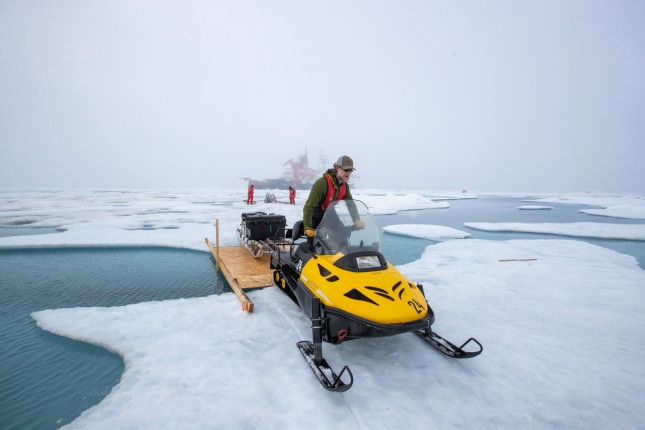-
Largest Polar Expedition Ever Seeks to Explain Shrinking Arctic Sea Ice

“If you’re a sea ice person, MOSAiC is the kind of experiment that you just live for,” said Don Perovich, a Dartmouth College researcher with the Multidisciplinary drifting Observatory for the Study of Arctic Climate. “It’s the kind of experiment you dream about. It’s an opportunity to spend a whole year on the ice, just watching how a floe evolves over time.” He spoke at a recent event sponsored by IARPC Collaborations, an Interagency Arctic Research Policy Committee (IARPC) member space where scientists and others involved in Arctic research share knowledge and resources. The researchers on the expedition, said Perovich, aimed to collect data that would shed light on the causes and consequences of the evolving and diminished Arctic sea ice cover. MOSAiC’s mission was to facilitate a breakthrough in understanding the Arctic climate system and improve the world’s climate and weather forecasting models.
Biggest Polar Expedition
The MOSAiC expedition drifted across the central Arctic Ocean, frozen in sea ice aboard the German icebreaker RV Polarstern from September 2019 to October 2020. As the largest polar expedition in history, the MOSAiC international climate research effort studied the Arctic atmosphere, ice, and ocean systems. It consisted of seven icebreakers or ships, more than 60 institutions, and over 400 experts in the field, said Matthew Shupe, MOSAiC’s Co-coordinator from University of Colorado. Twenty nations helped fund the mission and even more were represented in the team’s nationalities. The total budget was more than $150 million, including $40 million from the United States.
One of the key highlights of MOSAiC was the “sheer density of science” that was accomplished, said Shupe. MOSAiC researchers encompassed many disciplines, from chemistry to ecology to physics. The team took data on ocean circulation to study how sea ice is evolving; made atmospheric observations of clouds, precipitation, and aerosols; and measured energy and humidity fluxes to better understand interactions among the atmosphere, sea ice, and ocean. All MOSAiC data will be made freely available to the public by the beginning of 2023.
Among preliminary findings, the ice was thinner than the researchers had expected, said Shupe. Christopher Cox, a MOSAiC researcher from NOAA, said data showed a somewhat strong and prolonged polar vortex this year. Spring-like conditions began occurring at MOSAiC in mid-April, coinciding with the seasonal shift in the polar vortex.
Challenges Faced
Working on thinning ice can be dangerous. And the expedition encountered several challenges, said Shupe. First, ice cracks appeared near camp as Polarstern sat in a major ice shear zone. When those cracks come back together, the ridges would consume things. Operating out in this dynamic ice pack, he said, often meant that they had to frequently move installations and reinstall equipment. Entire power lines were consumed, causing temporary gaps in data.
Leg 3 of MOSAiC was extended by two months because travel restrictions prevented the expedition from rotating team members as planned, said Shupe. Due to COVID-19, the ship had to come out of the ice to meet the resupply vessels. The extra trip interrupted some of the measurements, he said. However, the challenges of the coronavirus pandemic also presented a unique opportunity to collect some unforeseen “bonus measurements” as they traveled within the ice pack out to the edge and back.
This leg was also marked by large-scale circulation and high Arctic oscillation indices, including unusually strong winds that blew the ice and the ship with it along the transpolar drift faster than anticipated, said Shupe. The complexity of the atmospheric systems gave the researchers, all the way up in the central Arctic, unique atmospheric research access to air masses that are warm and moist from the North Atlantic.
MOSAiC Moving Forward
While the expedition is over, MOSAiC is not done yet. Data will continue to be released for analysis over the next two years and analysis will require funding. During the IARPC Collaborations Expedition Overview Matthew Shupe said, “We’ve collected a great data set, but there’s so much analysis to do. So, I would say, the research is just beginning now, and we definitely need to continue to invest in the future of MOSAiC to really get the most out of that.”
Read More:
- A changing Arctic is rife with opportunities for international cooperation.
- The United States must act on Arctic ice melt and its implications.
- Climate change presents dual threats on the ocean and the cryosphere.
Michaela Stith is a Program Assistant for the Wilson Center’s Polar Institute.
Olivia Popp is a Staff Intern for the Wilson Center’s Polar Institute.
Sources: Interagency Arctic Research Policy Committee, MOSAiC
Photo Credit: Matthew Shupe drives a snowmobile over a bridge toward a measurement site on Jul 29, 2020, photo courtesy of Alfred-Wegener-Institut/Lianna Nixon (CC-BY 4.0).
 A Publication of the Stimson Center.
A Publication of the Stimson Center.



